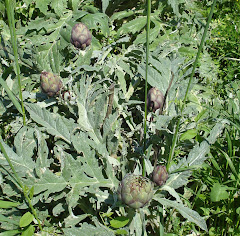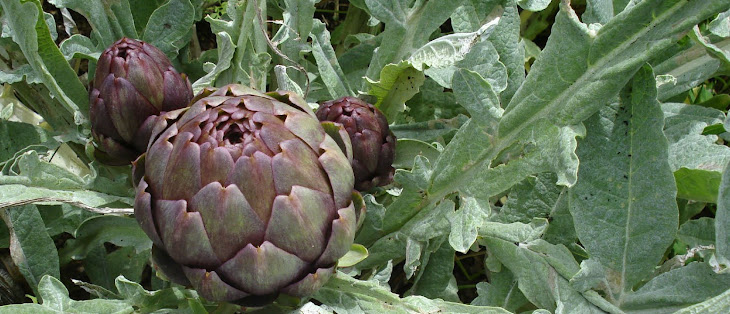We spent the weekend in Uzès, near Nîmes, a beautiful old town of narrow streets and turreted buildings. One of the highlights of our stay there was the Saturday market in the arcaded place aux Herbes.
 |  |
 |  |
Nous avons passé le weekend à Uzès, près de Nîmes, une belle vielle ville de ruelles étroites et de tourelles. Un des points forts de notre séjour était le marché à la place aux Herbes.
Under the arcade in one corner of the place we found La Maison de la Truffe - Uzès is a centre for the sale of truffles which grow under oak trees in the surrounding hills. I was shocked when I asked the price - over 700 € a kilo - but they are very light, so we were able to afford a couple of small ones as a treat.
Au coin de la place nous avons trouvé La Maison de la Truffe - Uzès est un centre de la production de la truffe. J'ai été étonnée quand j'ai demandé le prix - plus de 700 € le kilo - mais les truffes sont très légère, donc on en a pu acheter deux petites.
 more truffles than we could afford |  .... and one that we could |
 thinly sliced (beautiful patterns) |  and added to pasta with melted butter, a treat when we got home. |
And there's still one small truffle left which I'm going to use in other dishes, and I'll add a small piece to some olive oil to make truffle oil.
Vegetables stuffed with artichoke purée /
Les légumes farcis à la purée d'artichaut
We had some excellent meals in Uzès and one of the vegetable accompaniments which inspired me to experiment at home was a yellow pepper stuffed with a purée of artichoke hearts. In the summer I'll make this with our own vegetables from the garden, but when I found a stall in the market selling ready-made artichoke purée - caviare d'artichaut - I couldn't resist trying it with some courgettes and serving them today with olive bread from an organic bread stall.
Trying to think positively about building development / En essayant d'être optimiste quant au lotissement
I was upset to see that the building work on land around the gardens has now started. Trenches dug ready for foundations and services. We've known this has been planned for several years, but seeing it happening was a shock today. I'm trying to be positive about it. We should still have the same uninterrupted view from the garden and we're sheltered by old stone walls and bamboo. I tell myself I shouldn't be selfish - people need houses and why shouldn't they live on the hill next to our garden. I like having people around me, that's why I live in the village rather than in an isolated rural house ..... but I find it hard to accept that a small village like Gabian with 700 inhabitants, can absorb the increase in population which an extra 100 houses will bring without changing its character. We'll see.
Les travaux ont commencé sur le terrain autour des jardins. Vers 100 maisons. J'essaye d'être optimiste, mais c'est difficile d'accepter qu'un petit village de 700 habitants peut se developper sans changer son caractère. On vera.
Organic local food - the only hope for the planet / la nourriture bio et locale - le seul espoir pour la planète
If you haven't already read it, you should read Kate's recent post on Hills and Plains Seedsavers about the cost to the environment, to the planet and to all of us of industrialised agriculture. As Kate reports, it takes 10 calories of energy to produce 1 calorie of food using 'conventional' agriculture, whereas Producing food naturally, in your own backyard or close to home actually produces 10 calories of food for every 1 calorie put in to its production. How can we afford not to eat organic local food? There need to be huge changes in the way societies agree to produce food. Organic local food should no longer be seen as elitist and expensive - it has this reputation in developed countries, although it is considered normal in many other parts of the world. I can only hope that the global economic crisis can help to put a stop to the progress of large-scale food production and GM crops and begin a return to more rational methods.
L'agriculture globalisée et industrialisée prend 10 calories d'énergie pour produire 1 calorie de nourriture. La production naturelle, locale et biologique prend 1 calorie pour 10 calories de nourriture. Comment peut-on refuser la nourriture bio?









4 comments:
Alas, I have ranted against Globalisation from the beginning. Who would listen to little me, I am not sitting on the gravy train.
It was like "hail" Globalisation. They knew exactly what they were doing and still do!
Elitist food is that which comes from 10,000 miles away, from another hemisphere, and out of season! I long for that sea change. It will come, eventually. And maybe sooner than later.
On the other hand- MMMMmmmm truffles. Makes me realize I can't wait for morel season here in Michigan. Morels are simply astonishing.
Oh, if only people would boycott vegetables flown in from another country it would go some way towards a global change.
About the houses being built... You just have to hope that the impact will not be too big. Here, we are seeing the first phase of wind turbine erection coming to its conclusion which means that phase 2 is not far off, possibly this summer, when we will have two of the monsters right in front of us. We're not looking forward to it - never mind the disruption - but cling to the hope that it won't be as bad as we fear.
Belle promenade, j'adore les marches !
Post a Comment